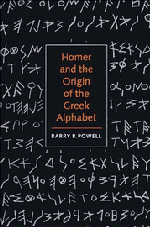Book contents
- Frontmatter
- Contents
- List of figures
- List of tables
- Acknowledgements
- Abbreviations
- A note on terms and phonetic transcriptions
- Chronological charts
- Maps
- Foreword: Why was the Greek alphabet invented?
- 1 Review of criticism: What we know about the origin Greek alphabet
- 2 Argument from the history of writing: How writing worked before the Greek alphabet
- 3 Argument from the material remains: Greek inscriptions from the beginning to c. 650 b.c.
- 4 Argument from coincidence: Dating Greece's earliest poet
- 5 Conclusions from probability: how the Iliad and Odyssey were written down
- APPENDIX I Gelb's theory of the syllabic nature of West Semitic writing
- APPENDIX II Homeric references in poets of the seventh century
- Definitions
- Bibliography
- Index
APPENDIX I - Gelb's theory of the syllabic nature of West Semitic writing
Published online by Cambridge University Press: 01 June 2011
- Frontmatter
- Contents
- List of figures
- List of tables
- Acknowledgements
- Abbreviations
- A note on terms and phonetic transcriptions
- Chronological charts
- Maps
- Foreword: Why was the Greek alphabet invented?
- 1 Review of criticism: What we know about the origin Greek alphabet
- 2 Argument from the history of writing: How writing worked before the Greek alphabet
- 3 Argument from the material remains: Greek inscriptions from the beginning to c. 650 b.c.
- 4 Argument from coincidence: Dating Greece's earliest poet
- 5 Conclusions from probability: how the Iliad and Odyssey were written down
- APPENDIX I Gelb's theory of the syllabic nature of West Semitic writing
- APPENDIX II Homeric references in poets of the seventh century
- Definitions
- Bibliography
- Index
Summary
…The Greeks were not the inventors of their alphabet, but themselves took it over readymade from the Phoenicians some time about the beginning of the ninth century b.c.…This [the Phoenician writing] is the earliest known alphabetic writing – that is, one in which each sign denotes one simple sound…
(J. Černý)The North Semitic alphabet was from the first moment of its existence a true alphabet; at least, as far as Semitic languages are concerned.
(D. Diringer)C'est [l'écriture consonnantique phénicienne] une écriture qui a banni les idéogrammes, mais qui au fond reste à quelque degré idéographique, puisqu'elle ne note que la racine, sans tenir compte de la vocalisation qu'elle peut recevoir.
(J. Février)I. J. GELB'S DESCRIPTION OF EGYPTIAN PHONETIC SIGNS AS CONSISTING SOLELY OF LOGOGRAMS AND SYLLABOGRAMS
In Chapter 2, “How Writing Worked before the Greek Alphabet,” I describe the phonography of Egyptian writing according to I. J. Gelb's thesis that each phonogram represents one (or more) consonants whose quality is clear, plus an understood vowel (or vowels), or absence of vowel(s), which must be provided by the native speaker. This is not a traditional view among Egyptologists, who prefer to view the phonograms of Egyptian as purely consonantal in nature, where each sign represents one, two, or three consonants, the so-called uniliterals, biliterals, and triliterals. According to this description of Egyptian phonography, the vowels are indeed to be provided by the native speaker, but they are not implicit in the sign.
- Type
- Chapter
- Information
- Homer and the Origin of the Greek Alphabet , pp. 238 - 245Publisher: Cambridge University PressPrint publication year: 1991



